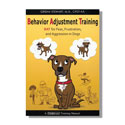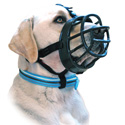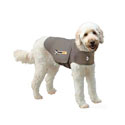Recently I was appointed to the board of the B.F. Skinner Foundation. The annual board meeting is held in Boston, and usually there's a reception afterwards at the Skinner family home in Cambridge, for members of the board and other people who share an interest in the work of the foundation. At the most recent reception, I was talking to a woman I'd met at the same gathering two years earlier, a museum curator with a special interest in scientific instruments—an interest I share. However, on this particular evening she didn't want to talk about her work, she wanted to talk about her cat.
It seems that when we had first met, two years earlier, this woman had also wanted to talk about her cat, and particularly its habit of jumping on the kitchen counters while she was cooking. She said that I had advised arranging some other, more suitable perch from which the cat could watch what's going on in the kitchen, and then clicker training the cat to use that perch. And she had done that.
Meanwhile, she had acquired a second cat, who had proved to be everything a cat lover could ask for. Cat Two never got on the counters. Cat Two, wanting attention, would lie down next to her and purr while she petted it.
Cat One, on the other hand, while enjoying its special perch in the kitchen, still jumped on the kitchen counters. The owner had followed advice (not my advice) to spray it with water, but now, even when she got out the spray bottle and spritzed Cat One, it just crouched, and wouldn't even jump down. It had also developed the habit, after she had retired for the night, of running around the bedroom knocking things off the bureau, and not only that, of knocking the pictures crooked (something no doubt particularly annoying to a museum curator).
The news about the pictures made me laugh, which was not a polite response. I guess I was supposed to solve the problem, but in fact I had no advice. The cat had trained her. In the kitchen she could easily be provoked into playing a game of "Chase the Cat." Now the cat had developed other ways of producing a round or two of this exciting game, even at times when the owner was not normally active, such as at bedtime.
Cats play-chase with each other, and in multi-pet households often develop chase games with dogs or even with house rabbits. Nothing unusual about it, except that the human had been suckered into more and more escalations of the game, without even knowing she was reinforcing the behavior she didn't want.
See cats training a dog—on video
This story reminded me of Joan Orr's delightful clicker DVD, Clicker Puppy. The program shows children, fourth and fifth graders mostly, clicker training an assortment of puppies to do all kinds of things. Joan and her husband David and their girls have two cats, one white, one gray: handsome young males adopted as adults from the Humane Society. While shooting the video, Joan brought a 4-month-old Portuguese water dog puppy into her house for a week. The puppy, of course, investigated both cats at once. Joan videotaped the initial encounters and the subsequent events.
In their first meeting, the white cat lay down, and responded minimally to the puppy's nosings. You can see this on the DVD. By and by, the puppy stopped trying to get the cat to move, and lay down, too. In short order the white cat and the puppy became "TV friends," often resting together by the sofa in the evening, maybe even cuddling.
The gray cat—and you can see this on the video, too—responded to the first advance by jumping up and swatting the puppy and then running off a little. Hurray! The puppy gave chase. The cat wasn't particularly frightened; from the beginning its movements looked play-related most of the time. In short order both the puppy and the gray cat enjoyed a good game of play-chase and play-fighting when they happened to meet.
The museum curator's two cats have taught her to play their own preferred games. One likes petting. And gets it. One likes pursuit. And gets it. Being scolded and spritzed is not a detriment; maybe it even adds to the excitement. And the behavior is so well trained! Two years, at least, of busy paw work have gone into it.
What are you actually reinforcing?
Dog behaviorists like to explain to pet owners that many of the things dogs do that we regard as problems are just natural behaviors in dogs. Yes, and many of the problems pet owners complain of are natural behaviors that have become exacerbated through inadvertent reinforcement by the owners.
Dogs pull on the leash because owners follow where the leash pulls them. From the dog's standpoint, as clicker trainer Carolyn Clark says, "That's how you walk your person." I once saw a woman who trained her Newfoundland to bark menacingly at her every time she went in the kitchen. How? Sooner or later, after telling it "No" and "Quiet" and "Go lie down" over and over, she gave it something to eat. Then it was quiet and went away temporarily. These are interlocking systems.
I'm not a pet behavior counselor. It's not my job, and in any case I'm not very interested in remedial work; I like building good new behaviors better than fixing bad old ones. However, I see a big element of hidden reinforcers in many behavior problems—not all, but many—that people bring to behaviorists: running away, barking, nipping, jumping up, pulling, etc. Maybe any problem should be addressed first, not by investigating the dog, but by investigating the environment. What reinforcer, or what long, variable ratio schedule, is maintaining this behavior so strongly?
Do you have one of these persistent behavior problems at your house? Maybe you can solve it on your own.
- Step One: Figure out what is actually reinforcing the behavior. And stop doing that.
- Step Two: Establish some other behavior that is a more acceptable way to earn reinforcement.
- Step Three: Use your reinforcing behavior to reinforce the alternate behavior.
That's all there is to it.
Isolating the behavior you are doing—that maintains the nuisance behavior—is counterintuitive and so it's difficult. We naturally want the pet's behavior to change, not our own. Emma Parsons's book, Click to Calm, Healing the Aggressive Dog, has wonderful tips on noticing what you are doing that reinforces the behavior you don't want and on changing your behavior so that it has a new meaning for the pet. Aggression doesn't need to be your problem, to benefit from Parsons's advice on ways to use your responses to build the behavior you like.
Do your pets do something you wish they wouldn't do? Ask yourself, "Am I actually reinforcing it?" And think about what you could be reinforcing, instead.








Post new comment